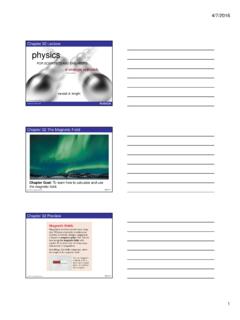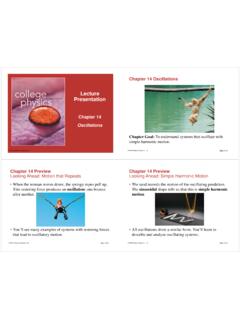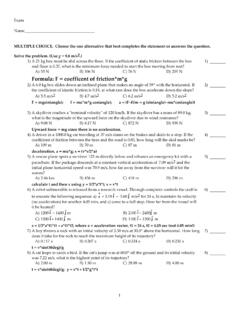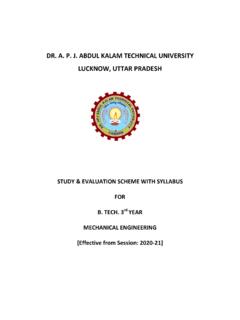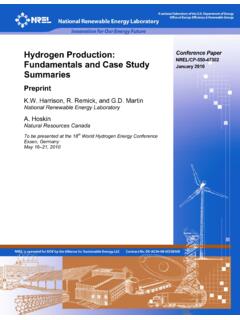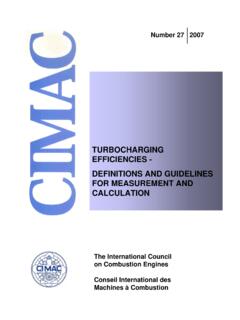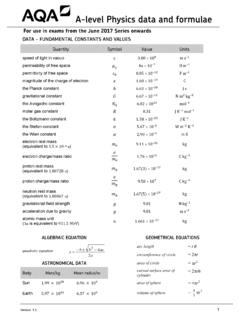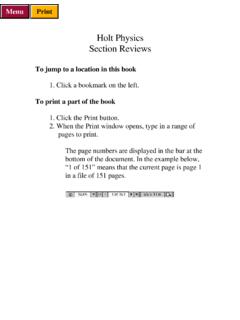Transcription of Chapter 19. Heat Engines and Refrigerators
1 Chapter 19. heat Engines and Refrigerators That's not smoke. It's clouds of water vapor rising from the cooling towers around a large power plant. The power plant is generating electricity by turning heat into work. Chapter Goal: To study the physical principles that govern the operation of heat Engines and Refrigerators . Copyright 2008 Pearson Education, Inc., publishing as Pearson Addison-Wesley. Chapter 19. heat Engines and Refrigerators Topics: Turning heat into Work heat Engines and Refrigerators Ideal-Gas heat Engines Ideal-Gas Refrigerators The Limits of Efficiency The Carnot Cycle Copyright 2008 Pearson Education, Inc., publishing as Pearson Addison-Wesley.
2 Chapter 19. Reading Quizzes Copyright 2008 Pearson Education, Inc., publishing as Pearson Addison-Wesley. What is the generic name for a cyclical device that transforms heat energy into work? A. Refrigerator B. Thermal motor C. heat engine D. Carnot cycle E. Otto processor Copyright 2008 Pearson Education, Inc., publishing as Pearson Addison-Wesley. What is the generic name for a cyclical device that transforms heat energy into work? A. Refrigerator B. Thermal motor C. heat engine D. Carnot cycle E. Otto processor Copyright 2008 Pearson Education, Inc., publishing as Pearson Addison-Wesley. The area enclosed within a pV curve is A. the work done by the system during one complete cycle.
3 B. the work done on the system during one complete cycle. C. the thermal energy change of the system during one complete cycle. D. the heat transferred out of the system during one complete cycle. Copyright 2008 Pearson Education, Inc., publishing as Pearson Addison-Wesley. The area enclosed within a pV curve is A. the work done by the system during one complete cycle. B. the work done on the system during one complete cycle. C. the thermal energy change of the system during one complete cycle. D. the heat transferred out of the system during one complete cycle. Copyright 2008 Pearson Education, Inc., publishing as Pearson Addison-Wesley. The maximum possible efficiency of a heat engine is determined by A.
4 Its design. B. the amount of heat that flows. C. the maximum and minimum pressure. D. the compression ratio. E. the maximum and minimum temperature. Copyright 2008 Pearson Education, Inc., publishing as Pearson Addison-Wesley. The maximum possible efficiency of a heat engine is determined by A. its design. B. the amount of heat that flows. C. the maximum and minimum pressure. D. the compression ratio. E. the maximum and minimum temperature. Copyright 2008 Pearson Education, Inc., publishing as Pearson Addison-Wesley. The engine with the largest possible efficiency uses a A. Brayton cycle. B. Joule cycle. C. Carnot cycle. D. Otto cycle. E. Diesel cycle.
5 Copyright 2008 Pearson Education, Inc., publishing as Pearson Addison-Wesley. The engine with the largest possible efficiency uses a A. Brayton cycle. B. Joule cycle. C. Carnot cycle. D. Otto cycle. E. Diesel cycle. Copyright 2008 Pearson Education, Inc., publishing as Pearson Addison-Wesley. Chapter 19. Basic Content and Examples Copyright 2008 Pearson Education, Inc., publishing as Pearson Addison-Wesley. Turning heat into Work thermodynamics is the branch of physics that studies the transformation of energy. Many practical devices are designed to transform energy from one form, such as the heat from burning fuel, into another, such as work. Chapters 17 and 18 established two laws of thermodynamics that any such device must obey.
6 Copyright 2008 Pearson Education, Inc., publishing as Pearson Addison-Wesley. heat Engines A heat engine is any closed-cycle device that extracts heat from a hot reservoir, does useful work, and exhausts heat to a cold reservoir. A closed-cycle device is one that periodically returns to its initial conditions, repeating the same process over and over. All state variables (pressure, temperature, thermal energy, and so on) return to their initial values once every cycle. A heat engine can continue to do useful work for as long as it is attached to the reservoirs. Copyright 2008 Pearson Education, Inc., publishing as Pearson Addison-Wesley. heat Engines Copyright 2008 Pearson Education, Inc.
7 , publishing as Pearson Addison-Wesley. heat Engines For practical reasons, we would like an engine to do the maximum amount of work with the minimum amount of fuel. We can measure the performance of a heat engine in terms of its thermal efficiency (lowercase Greek eta), defined as We can also write the thermal efficiency as Copyright 2008 Pearson Education, Inc., publishing as Pearson Addison-Wesley. Copyright 2008 Pearson Education, Inc., publishing as Pearson Addison-Wesley. Copyright 2008 Pearson Education, Inc., publishing as Pearson Addison-Wesley. EXAMPLE Analyzing a heat engine I. QUESTION: Copyright 2008 Pearson Education, Inc., publishing as Pearson Addison-Wesley.
8 EXAMPLE Analyzing a heat engine I. Copyright 2008 Pearson Education, Inc., publishing as Pearson Addison-Wesley. EXAMPLE Analyzing a heat engine I. Copyright 2008 Pearson Education, Inc., publishing as Pearson Addison-Wesley. EXAMPLE Analyzing a heat engine I. Copyright 2008 Pearson Education, Inc., publishing as Pearson Addison-Wesley. EXAMPLE Analyzing a heat engine I. Copyright 2008 Pearson Education, Inc., publishing as Pearson Addison-Wesley. EXAMPLE Analyzing a heat engine I. Copyright 2008 Pearson Education, Inc., publishing as Pearson Addison-Wesley. EXAMPLE Analyzing a heat engine I. Copyright 2008 Pearson Education, Inc., publishing as Pearson Addison-Wesley.
9 EXAMPLE Analyzing a heat engine I. Copyright 2008 Pearson Education, Inc., publishing as Pearson Addison-Wesley. EXAMPLE Analyzing a heat engine I. Copyright 2008 Pearson Education, Inc., publishing as Pearson Addison-Wesley. EXAMPLE Analyzing a heat engine I. Copyright 2008 Pearson Education, Inc., publishing as Pearson Addison-Wesley. Problem-Solving Strategy: heat - engine Problems Copyright 2008 Pearson Education, Inc., publishing as Pearson Addison-Wesley. Problem-Solving Strategy: heat - engine Problems Copyright 2008 Pearson Education, Inc., publishing as Pearson Addison-Wesley. Problem-Solving Strategy: heat - engine Problems Copyright 2008 Pearson Education, Inc.
10 , publishing as Pearson Addison-Wesley. Problem-Solving Strategy: heat - engine Problems Copyright 2008 Pearson Education, Inc., publishing as Pearson Addison-Wesley. Problem-Solving Strategy: heat - engine Problems Copyright 2008 Pearson Education, Inc., publishing as Pearson Addison-Wesley. Refrigerators Understanding a refrigerator is a little harder than understanding a heat engine . heat is always transferred from a hotter object to a colder object. The gas in a refrigerator can extract heat QC from the cold reservoir only if the gas temperature is lower than the cold-reservoir temperature TC. heat energy is then transferred from the cold reservoir into the colder gas.





